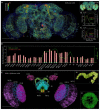Can Developments in Tissue Optical Clearing Aid Super-Resolution Microscopy Imaging?
- PMID: 34201632
- PMCID: PMC8268743
- DOI: 10.3390/ijms22136730
Can Developments in Tissue Optical Clearing Aid Super-Resolution Microscopy Imaging?
Abstract
The rapid development of super-resolution microscopy (SRM) techniques opens new avenues to examine cell and tissue details at a nanometer scale. Due to compatibility with specific labelling approaches, in vivo imaging and the relative ease of sample preparation, SRM appears to be a valuable alternative to laborious electron microscopy techniques. SRM, however, is not free from drawbacks, with the rapid quenching of the fluorescence signal, sensitivity to spherical aberrations and light scattering that typically limits imaging depth up to few micrometers being the most pronounced ones. Recently presented and robustly optimized sets of tissue optical clearing (TOC) techniques turn biological specimens transparent, which greatly increases the tissue thickness that is available for imaging without loss of resolution. Hence, SRM and TOC are naturally synergistic techniques, and a proper combination of these might promptly reveal the three-dimensional structure of entire organs with nanometer resolution. As such, an effort to introduce large-scale volumetric SRM has already started; in this review, we discuss TOC approaches that might be favorable during the preparation of SRM samples. Thus, special emphasis is put on TOC methods that enhance the preservation of fluorescence intensity, offer the homogenous distribution of molecular probes, and vastly decrease spherical aberrations. Finally, we review examples of studies in which both SRM and TOC were successfully applied to study biological systems.
Keywords: CLARITY; CUBIC; DISCO; clearing agents; light sheet; optical clearing; super-resolution; tissue clearing.
Conflict of interest statement
The authors declare no conflict of interest.
Figures







Similar articles
-
Imaging the mammary gland and mammary tumours in 3D: optical tissue clearing and immunofluorescence methods.Breast Cancer Res. 2016 Dec 13;18(1):127. doi: 10.1186/s13058-016-0754-9. Breast Cancer Res. 2016. PMID: 27964754 Free PMC article.
-
A method for ultrafast tissue clearing that preserves fluorescence for multimodal and longitudinal brain imaging.BMC Biol. 2022 Mar 29;20(1):77. doi: 10.1186/s12915-022-01275-6. BMC Biol. 2022. PMID: 35351101 Free PMC article.
-
Super-resolution microscopy: a brief history and new avenues.Philos Trans A Math Phys Eng Sci. 2022 Apr 4;380(2220):20210110. doi: 10.1098/rsta.2021.0110. Epub 2022 Feb 14. Philos Trans A Math Phys Eng Sci. 2022. PMID: 35152764 Free PMC article.
-
Super-resolution Microscopy for Biological Imaging.Adv Exp Med Biol. 2021;3233:23-43. doi: 10.1007/978-981-15-7627-0_2. Adv Exp Med Biol. 2021. PMID: 34053021 Review.
-
Fluorescence fluctuation-based super-resolution microscopy: Basic concepts for an easy start.J Microsc. 2022 Dec;288(3):218-241. doi: 10.1111/jmi.13135. Epub 2022 Aug 9. J Microsc. 2022. PMID: 35896096 Free PMC article. Review.
References
-
- Smith D.J. Ultimate Resolution in the Electron Microscope? Mater. Today. 2008;11:30–38. doi: 10.1016/S1369-7021(09)70005-7. - DOI
-
- Lu C.-H., Tang W.-C., Liu Y.-T., Chang S.-W., Wu F.C.M., Chen C.-Y., Tsai Y.-C., Yang S.-M., Kuo C.-W., Okada Y., et al. Lightsheet Localization Microscopy Enables Fast, Large-Scale, and Three-Dimensional Super-Resolution Imaging. Commun. Biol. 2019;2:1–10. doi: 10.1038/s42003-019-0403-9. - DOI - PMC - PubMed
Publication types
MeSH terms
Substances
Grants and funding
LinkOut - more resources
Full Text Sources
Research Materials

